 W
WThe invasion of Poland marked the beginning of World War II. The German invasion began on 1 September 1939, one week after the signing of the Molotov–Ribbentrop Pact between Germany and the Soviet Union, and one day after the Supreme Soviet of the Soviet Union had approved the pact. The Soviets invaded Poland on 17 September. The campaign ended on 6 October with Germany and the Soviet Union dividing and annexing the whole of Poland under the terms of the German–Soviet Frontier Treaty.
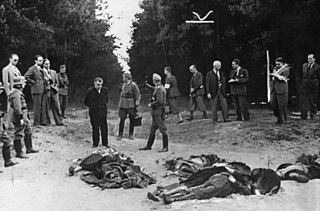 W
WBloody Sunday was a sequence of violent events that took place in Bydgoszcz, a Polish city with a sizable German minority, between 3 and 4 September 1939, during the German invasion of Poland.
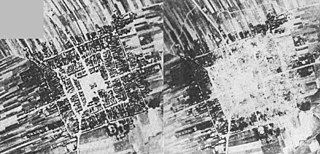 W
WThe Bombing of Frampol occurred during the German invasion of Poland in 1939. On 13 September, the town of Frampol with a population of 4,000 was bombed by the German bombers of Luftwaffe's 8th Air Corps, under General Wolfram Freiherr von Richthofen. The town had no military value, and the bombing was seen as a practice run for future missions.
 W
WThe Bombing of Warsaw in World War II refers to the aerial bombing campaign of Warsaw by the German Luftwaffe during the siege of Warsaw in the invasion of Poland in 1939. It also may refer to German bombing raids during the Warsaw Uprising in 1944. During the course of the war approximately 85% of the city was destroyed due to German mass bombings, heavy artillery fire and a planned demolition campaign.
 W
WThe bombing of Wieluń is considered by many to be the first major act of World War II, and the September Campaign. After Luftwaffe air units moved into Polish airspace in the early morning of 1 September, they reached the town of Wieluń by 04:40-45 hours. Around this time, the first strikes on the town were conducted, with a total of 46,000 kg bombs being dropped on civilian targets for 9 consecutive hours. Elsewhere, the Battle of Westerplatte and Danzig skirmishes began around the same time, starting the well-coordinated Invasion of Poland.
 W
WDeutsche Vereinigung (DV), or the German Union, was a Nazi German extreme right-wing political party founded in 1934 by members of the ethnic German minority residing in the Second Polish Republic.
 W
WDeutscher Volksverband in Polen (DVV), or the German People's Union in Poland, was a Nazi German extreme right-wing political party founded in 1924 in central Poland by members of the ethnic German minority who did not wish to join the minority bloc in the Polish parliament Sejm. DVV was headed by August Utta, and financially supported by the Reich Ministry of Finance. Deutscher Volksverband was most active in the Łódź and Tomaszów area.
 W
WFall Weiss was the German strategic plan for the invasion of Poland. The German military High Command finalized its operational orders on 15 June 1939 and the invasion commenced on 1 September, precipitating World War II.
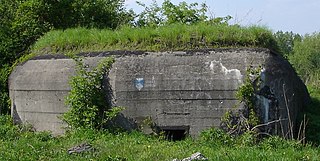 W
WThe Fortified Area of Silesia was a set of Polish fortifications, constructed along the interbellum border of Poland and Germany in the area of then-divided Upper Silesia. It spreads from the village of Przeczyce in the north to the town of Wyry in the south, along the line of sixty kilometers. Headquarters of the area was placed in Chorzów and its commandant was General Jan Jagmin-Sadowski.
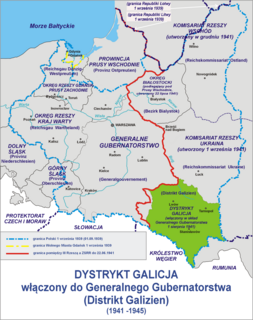 W
WThe District of Galicia was a World War II administrative unit of the General Government created by Nazi Germany on 1 August 1941 after the opening of Operation Barbarossa. Initially, during the invasion of Poland by Germany and the Soviet Union, the territory temporarily fell under the Soviet occupation in 1939 as part of Soviet Ukraine.
 W
WThis article details the order of battle of German military units during the invasion of Poland in 1939.
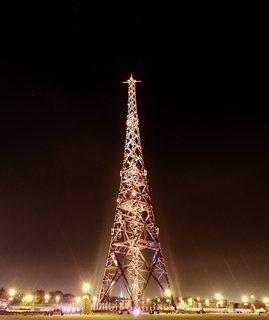 W
WThe Gleiwitz incident was a false flag attack on the German radio station Sender Gleiwitz, staged by Nazi Germany on the night of 31 August 1939. Along with some two dozen similar incidents, the attack was manufactured by Germany as a casus belli to justify the invasion of Poland, which began the next morning. The attackers posed as Polish nationals.
 W
WThe Hel Fortified Area was a set of Polish fortifications, constructed on the Hel Peninsula in northern Poland, in close proximity to the interwar border of Poland and the Third Reich. It was created in 1936, upon a decree of President Ignacy Moscicki. It covered most part of the peninsula, and during Polish September Campaign, it was the last place of Poland to surrender to the invading Wehrmacht. During World War II, the naval base in Hel was used as a major training facility for U-boat crews.
 W
WOperation Himmler was a 1939 false flag project planned by Nazi Germany to create the appearance of Polish aggression against Germany, which was subsequently used by the Nazis to justify the invasion of Poland. This included staging false attacks on themselves using innocent people or concentration camp prisoners. Operation Himmler was arguably the first act of the Second World War in Europe.
 W
WJabłonków incident refers to the events of the night of August 25/26, 1939, along the Polish-Slovak border, when a group of German Abwehr agents attacked a rail station in Mosty. The main purpose of the attack was to capture the Jablunkov Pass, with its strategic railroad tunnel, until the arrival of the German armed forces. The attackers were repelled by units of the Polish Army, and the incident is regarded as a prelude to the German invasion of Poland. The Jabłonków Incident has been named the first commando operation of the Second World War.
 W
WJungdeutsche Partei in Polen (JDP), or the Young German Party in Poland, was a Nazi German extreme right-wing political party founded in 1931 by members of the ethnic German minority residing in the Second Polish Republic.
 W
WTadeusz Adam Kasprzycki was a member of the Polish Legions in First World War, major general of the Polish Army from 1929 and Minister of Military Affairs of Poland from 1935 to 1939. He commanded the 12th Infantry Division from 1927 to 1931.
 W
WJózef Stanisław Łobodowski was a Polish poet and political thinker.
 W
WLotna is a 1959 Polish war film directed by Andrzej Wajda.
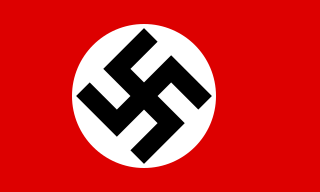 W
WThe Military Administration in Poland refers to the military occupation authorities established in the brief period during, and in the immediate aftermath of, the German invasion of Poland, in which the occupied Polish territories were administered by the German military (Wehrmacht) as opposed to the later civil administration and the General Government.
 W
WThe German–Soviet military parade in Brest-Litovsk was an official ceremony held by the troops of Nazi Germany and the Soviet Union on September 22, 1939, during the invasion of Poland in the city of Brest-Litovsk. It marked the withdrawal of German troops to the demarcation line secretly agreed to in the Molotov–Ribbentrop Pact, and the handover of the city and its fortress to the Soviet Red Army.
 W
WOperation Tannenberg was a codename for one of the anti-Polish extermination actions by Nazi Germany that was directed at the Poles during the opening stages of World War II in Europe, as part of the Generalplan Ost for the German colonization of the East. The shootings were conducted with the use of a proscription list, compiled by the Gestapo in the span of two years before the 1939 invasion.
 W
WPlan Zachód was a military plan of the Polish Army of the Second Polish Republic, for defence against invasion from Nazi Germany. It was designed in the late 1930s.
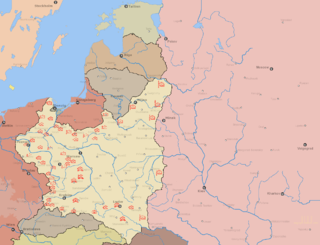 W
WPolish OOB during the invasion of Poland. In the late thirties Polish headquarters prepared "Plan Zachód", a plan of mobilization of Polish Army in case of war with Germany. Earlier, the Poles did not regard the Germans as their main threat, priority was given to threat from the Soviets.
 W
WThe Southern Front was one of two fronts of the Polish Army created during the Invasion of Poland of 1939 against the allied forces of Nazi Germany and Soviet Union. It was established on September 12 out of the Polish Armies Karpaty and Kraków, as well as several military units created behind the front-lines.
 W
WThe Riverine Flotilla of the Polish Navy, better known as the Pinsk Flotilla, was the inland branch of the Polish Navy operating on the Vistula river and in the area of the Pinsk Marshes between the Polish–Bolshevik War and World War II. Under Commodore Witold Zajączkowski, it was active in the invasion of Poland and fought against both German and Soviet forces.
 W
WSiege is a 1940 documentary short about the Siege of Warsaw by the Wehrmacht at the start of World War II. It was shot by Julien Bryan, a Pennsylvanian photographer and cameraman who later established the International Film Foundation.
 W
WThe Slovak invasion of Poland occurred during Germany's invasion of Poland in September 1939. The recently created Slovak Republic joined the attack, and the Slovak Field Army Bernolák contributed over 50,000 soldiers in three divisions. As the main body of the Polish forces were engaged with the German armies farther north of the southern border, the Slovak invasion met only weak resistance and suffered minimal losses.
 W
WThe Soviet invasion of Poland was a military operation by the Soviet Union without a formal declaration of war. On 17 September 1939, the Soviet Union invaded Poland from the east, sixteen days after Germany invaded Poland from the west. Subsequent military operations lasted for the following 20 days and ended on 6 October 1939 with the two-way division and annexation of the entire territory of the Second Polish Republic by Nazi Germany and the Soviet Union. This division is sometimes called the Fourth Partition of Poland. The Soviet invasion of Poland was indirectly indicated in the "secret protocol" of the Molotov–Ribbentrop Pact signed on 23 August 1939, which divided Poland into "spheres of influence" of the two powers and questioned the future existence of the Polish state.
 W
WThe Worek Plan was an operation of the Polish Navy in the first days of World War II, in which its five submarines formed a screen in order to prevent German naval forces from carrying out landings on the Polish coast, and to attack enemy ships bombarding Polish coastal fortifications, in particular the base on the Hel Peninsula.
 W
WWrzesień żagwiący is a 1947 book of literary reportage written by the Polish historian and political journalist Melchior Wańkowicz. The book is a collection of analytical thinking stories written by Wańkowicz in the early 1940s, while the author was in exile. Following the invasion of Poland, he left the country in late September 1939 for Romania, later moving to Cyprus, BritishPalestine, Italy, and finally, to London. Wrzesień żagwiący gives a vivid account of the Polish September Campaign; its title refers to the fact that Nazi Germany, together with the Soviet Union invaded the Second Polish Republic jointly in September 1939. The book was first published in 1947, in London, by Gryf Publishing House. It was reprinted in 1990 by Polonia Publishing House, while several stories from the book were printed separately, with the most popular one, Westerplatte, having been printed in 1959, 1960, 1963, 1967, 1968, 1971, 1989, and 1990. In August 2009, Warsaw publishing house Prószyński i Spółka reprinted the book in the third volume of collected works by Wańkowicz. In this volume, Wrzesień żagwiący is published together with other war-related stories, such as Strzępy epopei, Szpital w Cichiniczach, and Po klęsce.